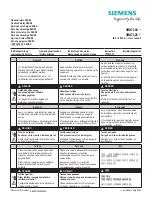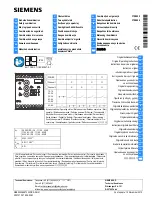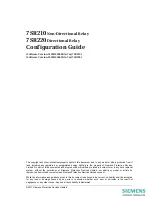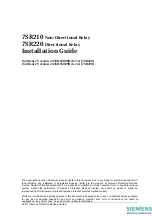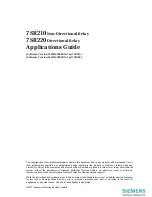
The time dial setting determines the limit the recursive sum must reach for a trip.
Negative-Sequence Directional Element
You can enable the negative-sequence directional element to provide directional supervision of
the residual overcurrent elements. The negative-sequence directional elements always
supervises the distance elements.
The negative-sequence directional elements are phasor-product derived. The product is
negative-sequence voltage times negative-sequence current adjusted by the maximum torque
angle setting. The relay declares a fault forward when I2 leads V2 ±90° from the maximum
torque angle.
Table 2.8 shows the equation the relay uses to express the sensitivity of the directional
element in units of torque. These equations are useful in determining directional element
sensitivities for fault angles which may differ from the MTA.
Table 2.8: Directional Element Torque Equations
Where:
T
≡
Torque, positive for a forward fault
V2
≡
Negative-sequence secondary voltage
I2
≡
Negative-sequence secondary current
Programmable Logic Mask Concept
Figure 2.9 illustrates the concept of the programmable logic mask by comparing it to the
connections of discrete relay elements. At the top, the figure shows relay element contacts X,
Y, and Z connected to a common reference, such as the positive pole of a battery. The other
ends of these contacts pass through knife switches, while the other side of the switches are
connected to drive an auxiliary relay labelled A1. The knife switch positions select relay
elements which can pick up the auxiliary relay.
In the figure, switches SX and SY are closed, so closure of either contact X or Y causes A1
to pick up. The figure expresses this process in Boolean terms next to the A1 output contact
with the notation X + Y. The "+" indicates a logical "OR" operation.
The A1 contact control logic scheme may be modified by setting switches SX, SY, and SZ to
other positions. If an application requires combinations of contacts X, Y, and Z to control
other auxiliary relays, diodes must be used in each contact path. This ensures that the logic
settings for this scheme do not affect other auxiliary relays. Since each output contact has a
separate logic mask, this step is unnecessary in the microprocessor based relay.
2-36
Specifications
SEL-221F, -1 Instruction Manual
Date Code 920508
Содержание SEL-221F
Страница 3: ......
Страница 8: ...Time Curve C1 Time Curve C2 Time Curve C3 Time Curve C4 Date Code 961202 SEL 221F Relay Addendum 3 ...
Страница 10: ......
Страница 11: ......
Страница 12: ......
Страница 13: ......
Страница 69: ...Date Code 920508 Specifications SEL 221F 1 Instruction Manual 2 44 ...
Страница 70: ...Date Code 920508 Specifications SEL 221F 1 Instruction Manual 2 45 ...
Страница 71: ...Date Code 920508 Specifications SEL 221F 1 Instruction Manual 2 46 ...
Страница 72: ...Date Code 920508 Specifications SEL 221F 1 Instruction Manual 2 47 ...
Страница 110: ...Example Event Report 2 4 12 Event Reporting SEL 221F 1 Instruction Manual Date Code 930830 ...
Страница 158: ...SETTINGS SHEET FOR SEL 221F RELAY PAGE 2 OF 6 DATE Date Code 921110 ...
Страница 160: ...SETTINGS SHEET PAGE 4 OF 6 FOR SEL 221F RELAY DATE Date Code 930601 ...
Страница 161: ...SETTINGS SHEET PAGE 5 OF 6 FOR SEL 221F RELAY DATE Date Code 961208 ...
Страница 170: ...Figure 6 2 Horizontal Front and Rear Panel Drawings Date Code 920508 Installation 6 7 SEL 221F 1 Instruction Manual ...
Страница 174: ...Figure 6 8 Dc External Connection Diagram Typical Date Code 920508 Installation SEL 221F 1 Instruction Manual 6 11 ...
Страница 228: ...APPENDICES TABLE OF CONTENTS Parts Placement Diagram Date Code 920508 Table of Contents SEL 221F 1 Instruction Manual i ...
Страница 229: ...SEL 200 Series Relay Main Board Troubleshooting Test Points and Jumper Locations ...

































